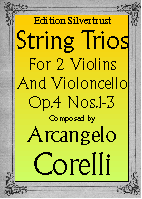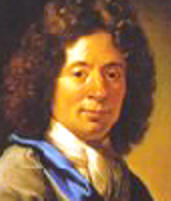Presents
Arcangelo Corelli
String Trios for 2 Violins & Cello, Op.4 Nos.1-3
|
String Trio Op.4 No.1 |
 |
 |
String Trio Op.4 No.3 |
|
Our Soundbites are an example of strings with optional harpsichord which doubles the cello part |
Arcangelo Corelli (1653-1713) was born in the Italian village of Fusignano near Bologna. He studied the violin locally and began a career as a traveling virtuoso for several years, playing at many of the Royal Courts of Europe before permanently settling in Rome in 1674. Corelli lived at a time when the violin was emerging as the most important of all concert instruments. It was the age of the great violin makers--Stradivarius, Amati and Guarnerius--and the craze for the new music being composed for the violin swept across northern Italy, which became the birthplace of the Baroque sonata. Corelli revolutionized violin playing and his trio sonatas, which were studied by Bach, Telemann and Vivaldi to name but a few, are widely regarded as the beginning of chamber music as we know it.
His Op.4 was a set of 12 trio sonatas (sonata a tre) written for two violins and cello (basso continuo). However, although the bass line is written out only as an unadorned melodic line, Corelli placed figures under the notes (as was the common practice) to indicate a plan for harmonization should the ensemble wish to add a keyboard player, again a common practice. The keyboard player was expected to take the unadorned bass line and realize it, i.e. play chords while the bass line was being played, in other words, to create a fully worked out harpsichord part. However, the keyboard part is purely optional and the trio for strings was certainly designed to stand on its own without keyboard. Corelli's trios were ground breaking works because the bass line was no longer a mere background accompaniment for the melody, but an independent part of its own and sometime allowed to take the lead.
These trios are not only historically important but also fine examples of the Baroque trio sonata. We offer Trio Nos. 1 and 3 separately as they are somewhat longer than No.2, which can also be had if you purchase them as a group.